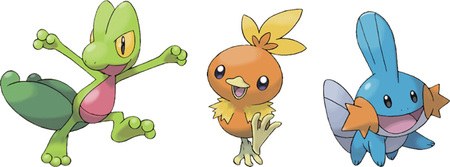Pokémon Ruby & Sapphire
Pokémon moves into its third generation with Pokémon Ruby & Pokémon Sapphire for Nintendo Game Boy Advance, bringing along some big changes in battle mechanics and Pokémon training.
Details
| Platform | Game Boy Advance |
|---|---|
| Director | Junichi Masuda |
| New Pokémon | 135 |
| New moves | 103 |
| New abilities | 76 |
Release dates
| Japan | 21st November 2002 |
|---|---|
| America | 19th March 2003 |
| Europe | 25th July 2003 |
| Australia | 3rd April 2003 |
Gameplay
Ruby & Sapphire follows the usual pattern of training and catching Pokémon, battling through eight gyms and then the Elite Four and Champion. The game starts in Littleroot Town in the Hoenn region. You have just moved to town due to your father becoming a gym leader. After meeting Professor Birch out in the wild you choose a starter Pokémon - Treecko, Torchic or Mudkip.
On your journey you must also defeat the evil Team Magma (Ruby) or Team Aqua (Sapphire), whose want to use a legendary Pokémon to change the climate of Hoenn. In Ruby, Team Magma aim to awaken Groudon to expand the landmass of Hoenn; in Sapphire, Team Aqua aim to awaken Kyogre to expand the oceans and flood Hoenn.

The Hoenn starters: Treecko, Torchic and Mudkip
New Pokémon mechanics
The biggest change in Ruby/Sapphire was a less apparent one - a complete redevelopment of how Pokémon data is stored in-game. As such, Pokémon cannot be traded to generation 3 from any previous game.
Directly tied to the new data format was an overhauled Effort Value (EV) and Individual Value (IV) system. IVs now have a wider range, giving more individuality to Pokémon in the wild.
EVs became more restricted and targeted. In previous games battling with your Pokémon simply increased EVs across all stats, up to a maximum. From Ruby/Sapphire onwards, each Pokémon battled yields small EV increases in specific stats. However, there is a maximum for each stat plus an overall maximum (roughly equivalent to two maxed-out stats). See the Effort Values page for more details.
Abilities
One of the biggest visible changes in Ruby/Sapphire was the introduction of Abilities. These are special traits which have a variety of effects in battle, or in some cases out in the field. Each Pokémon can only have one ability, though most species have two options that are randomly chosen upon encounter. See the Abilities page for more details.
Natures
Pokémon also gained Natures in generation 3, making each Pokémon even more unique and giving each one a personality
. Natures will increase one of the Pokémon's stats and decrease another stat, adding yet another layer to battle strategy. There are 25 natures in total, one of which is randomly assigned upon encounter. See the Natures page for more details.
Double battles
A new concept of double battles was introduced, expanding battle strategies further. All moves now have a target
which could include both opposing Pokémon or all Pokémon in battle, although most moves still target one Pokémon.
Other features
- Pokémon Contests were introduced as a way to show off other non-battle attributes. They made use of the new Pokémon data format by adding new attributes Beauty, Cool, Cute, Smart and Tough. These stats can be increased by making Pokéblocks and feeding them to Pokémon. In contests, Pokémon are first judged on these attributes, and then
appeal
by using certain moves. - Weather conditions can also be seen outside of battle are a significant part of the storyline. Specifically, rain can be seen on Route 119 and a sandstorm in the desert on Route 111. Weather in the overworld also occurs in battles in those places. New abilities also appear that generate weather as the Pokémon
- Hail is added as a new weather condition along with a move of the same name.


